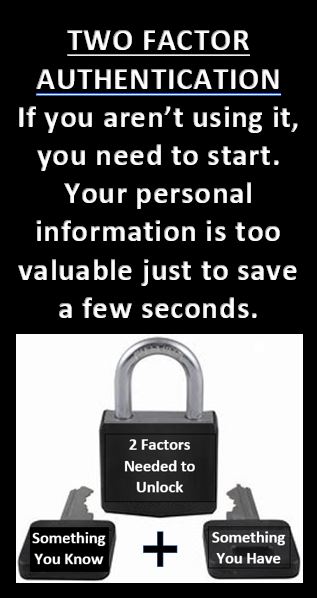What is 2-Factor Authentication?
In the simplest terms, 2-factor authentication (also known as 2-step verification) is a method of verifying your identity by using a temporary secondary passcode. In theory, only you have access to this temporary passcode because it is sent to a device you have physical control of. It works like this:
- Log in to your account using your username and password
- A new login screen pops up advising you to check your email or phone for your temporary code. (in some cases, you may be given the option where to send the code and fill in some additional information)
- Enter the code you just received in the login screen and you gain access to your account.
Use of 2-factor authentication is a relatively painless process even if it does take a few additional seconds to login.
Additionally, biometrics and one-time passwords can also add an extra layer of security for your sensitive accounts.
Why Use 2-Factor Authentication?
Now that you know the simple answer to the question “What is 2-factor authentication?”, you probably want to know why you should be bothered with it. After all, you have a unique username and a strong password (hopefully). Unfortunately, that may not be, and often is not, enough to keep hackers from accessing your accounts. No account is ever 100% secure, even with 2-factor authentication, but adding this extra step reduces your risk significantly.
Unless you have been on a deserted island for the last few years, you have undoubtedly read or heard news about major corporations, financial institutions, health care providers and social media giants (among others) being hacked resulting in the loss of valuable consumer account information. And of course, when you learn of these data breaches, you rush to your computer and update all your passwords, right? What if the hackers beat you to it?
If the bad guys gain access to your email account and other user information, they may be able to reset your password and lock you out. However, if you have 2- factor authentication set-up to send you a text message, you will know if someone is attempting to do that.
One critical question we should all ask ourselves is, how much time is our online security worth?
Methods – which should I use?
Two-factor authentication can be configured to use text to your mobile device, email or authenticator apps.
- Text messaging is very secure if you don’t lose your phone. Assuming you always have your phone in your possession, it is a simple task to enter the code you receive via text to access your account.
- Email may not be the best method. While using email to authenticate your account is better than not using 2-factor authentication, there is the chance for your email to be compromised thus giving hackers access to your 2-factor authentication codes when emailed.
- Authenticator apps are offered by several companies, Google, Microsoft offer another method to access a code but have some limitations. Not all apps work with all accounts so you might need to use multiple authenticator apps. You set up the authenticator for each account then must launch the authenticator on your mobile device to receive a code.
- Other methods such as one-time passwords and biometrics also have their place, but I will not delve into those at this time.
Setting up 2-Factor Authentication
Each account will likely have a different method, so it is not practical to list them all here. The basic task requires that you be signed into your account and find your login or security settings, enable 2-factor authentication and select one or more ways to receive your code. Follow your providers instructions.
I invite you to review the
“two-factor-authentication-cheat-sheet” on techrepublic.com for more information. There are also more specific instructions to set up two-factor authentication for the following:
Don’t wait until your valuable accounts have been compromised before you decide it is time to activate two-factor authentication. Be proactive and protect yourself today

